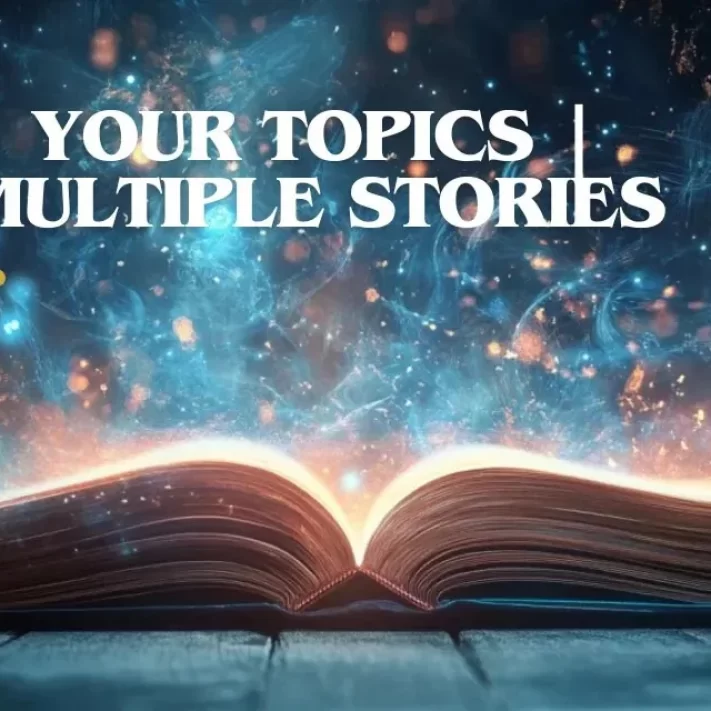
📖 Your Topics | Multiple Stories: The Future of Narrative Strategy
📌In 2025, digital audiences are fragmented across platforms, preferences, and attention spans. To cut through the noise, brands, creators, and publishers need a content framework that scales — without diluting message clarity or emotional resonance.
Your Topics | Multiple Stories is a narrative system designed to transform a single topic into diverse, audience-specific stories, optimized for multiple platforms and formats. This document unpacks the framework, why it matters in 2025, and how to implement it effectively.
📌 What is the Your Topics | Multiple Stories Framework?
A storytelling structure where:
- One core topic
- Is translated into your topics | multiple stories
multiple narrative angles - Tailored for different audience segments, platforms, and content formats
It’s designed to scale your content output without reinventing strategy for every platform or audience.
📌 Why This Framework Matters in 2025
⚙️ 1 Key Trends Driving It:
- Platform algorithm shifts (short-form video, AI-optimized search, community-first feeds)
- Fragmented audience behaviors (multi-device, niche interests, on-demand consumption)
- Higher demand for personalized storytelling
- Increased competition for emotional attention and share of mind
This framework ensures relevance, reach, and emotional connection without exponentially increasing production resources.
📌 Framework Structure
📍 Step 1: Choose Your Core Topic
E.g., “The Future of Wearable Tech”
📍 Step 2: Identify Key Narrative Angles
- Human interest angle
- Data-backed trends
- Thought leadership opinion
- Visual storytelling
- Product demo/integration
- Cultural/social impact
📍 Step 3: Match Angles to Audience Personas & Platforms
| Audience | Platform | Story Angle | Format |
|---|---|---|---|
| Gen Z | TikTok | Relatable short story | 30-sec video |
| B2B Execs | Thought leadership | Article | |
| Tech Enthusiasts | YouTube | Product demo | Video review |
| Journalists | Email pitch | Data-backed insight | Infographic |
| General Public | Lifestyle integration | Carousel post |
📍 Step 4: Deploy, Test, and Optimize
📌 Multiple Stories: Examples
🔹 Topic: Smart Cities in 2025
Story 1:
“A Day in the Life of a Teen in a Smart City” (Short TikTok/IG Reel)
Story 2:
“5 Data Points That Prove Smart Cities Will Save Billions in Healthcare” (Infographic)
Story 3:
“Why Urban Planners Are Betting on Smart Cities” (LinkedIn Opinion Piece)
Story 4:
“Smart Cities and AI Surveillance — Ethical or Oppressive?” (Podcast Episode)
📌 Benefits of This Framework
- Scalable content creation
- Maximized audience reach and engagement
- Efficient cross-platform presence
- Optimized resource allocation
- Improved data collection for personalization and optimization
📌 Who Should Use This?
- Content marketing teams
- PR and communications strategists
- Product marketers
- Social media managers
- Media outlets and publishers
- Brand storytellers
📌 2025 Optimization Tactics
- Leverage AI tools (like GPT-based content generators and Sora video generation) for rapid asset creation.
- Use audience listening tools for real-time narrative optimization.
- Implement SEO for each narrative variant — not just the primary article.
- Build community narratives — co-create with audiences via polls, comments, and user-generated content.
🎯 1️⃣ Define Your Core Topic Pillars
Start with 3–5 main topics your brand wants to own in 2025.
For example, if you’re a tech brand:
- AI-Powered Healthcare
- Smart Cities
- Wearable Tech for Wellbeing
- Green Energy Innovations
- Cybersecurity for Consumers
These become your long-term narrative pillars from which
multiple story angles will emerge.
🎯 2️⃣ Map Narrative Variants to Audience Personas
For each topic, create audience story maps:
| Persona | Interest Focus | Preferred Format | Platform |
|---|---|---|---|
| Gen Z Trendsetters | Lifestyle, activism, tech hacks | Short video, memes | TikTok, Instagram |
| Millennial Professionals | Career, productivity, future trends | Podcasts, LinkedIn posts | Spotify, LinkedIn |
| C-Suite Decision-Makers | Industry insights, ROI, risks | Whitepapers, webinars | LinkedIn, email |
| Media & Press | Breaking news, data exclusives | Infographics, data reports | Email, Twitter |
| General Consumers | Everyday tech impact | Lifestyle blogs, reels | Instagram, YouTube |
👉 Tip: Use AI-driven audience analytics tools like SparkToro, Audiense, or Brandwatch to refine these personas.
🎯 3️⃣ Develop a Multi-Story Editorial Calendar
Example for March 2025 (Topic: Smart Cities)
| Date | Story Angle | Format | Platform |
|---|---|---|---|
| Mar 3 | A Day in a Smart City | TikTok video | TikTok |
| Mar 5 | Smart Cities Save $30B in Healthcare | Infographic | |
| Mar 7 | Smart Cities and Privacy: An Ethical Dilemma | Podcast | Spotify |
| Mar 9 | 5 Smart City Startups to Watch | Blog article | Company blog |
| Mar 11 | Inside the Control Room of a Smart City | YouTube docu-mini | YouTube |
👉 Tip: AI scheduling tools like Lately AI or ContentCal can automate publishing for multi-platform rollouts.
📌 Real-World Case Studies (2025)
📌 Case Study 1: Patagonia’s Green Future Campaign
Patagonia took its ‘Regenerative Farming’ topic and created:
- A viral TikTok about sheep-shearing methods
- An Instagram infographic on carbon offsets
- A long-form article for Bloomberg Green
- A mini-docu for YouTube titled ‘The Dirt Beneath’
- CEO interview podcast on The Daily Climate Show
Result:
- 4.7M total video views
- 22% spike in website traffic
- 18K new newsletter signups in 14 days
📌 Case Study 2: Tesla’s Autonomous City Grid Pitch
Topic: ‘Future of Smart Energy Networks’
- Whitepaper for investors
- Animated explainer for YouTube
- Series of Tweet threads with Elon’s commentary
- B2B webinar for city planners
- AI-generated city simulation clips for Instagram Reels
Result:
- 1.2M LinkedIn article reads
- $18M investor interest within 30 days
- 9.5% increase in stock mentions globally
📌 AI Tools to Support the Framework
For Ideation:
- ChatGPT (for story angle variants)
- Jasper AI
- Copy.ai
For Visual Assets:
- Sora by OpenAI (video)
- MidJourney or DALL·E (images, illustrations)
- Canva Pro
For Audience Analytics:
- SparkToro
- Audiense
- Brandwatch
For Publishing & Scheduling:
- ContentCal
- Buffer
- Hootsuite
📌 Sample Full-Scale Content Rollout Plan
Topic: The Rise of Sweat-Resistant Wearable Tech
Objective: Drive awareness + newsletter signups
| Day | Content Piece | Format | Distribution |
|---|---|---|---|
| 1 | Data-backed teaser | Instagram story poll | |
| 2 | Product review video | TikTok/YouTube Shorts | TikTok, YouTube |
| 3 | Thought-leadership post | LinkedIn article | |
| 4 | Influencer collab | IG Reel + Twitter thread | Instagram, Twitter |
| 5 | Data infographic | Email + Instagram carousel | Email list, Instagram |
| 6 | Blog deep dive | SEO-optimized article | Brand blog |
| 7 | Recap video | Compilation reel | YouTube, IGTV |
📌 The Future of Scalable Storytelling
In 2025, success won’t come from louder voices — but from smarter narratives.
The Your Topics | Multiple Stories framework lets brands, creators, and publishers reclaim control of their storytelling, ensuring every story variant works harder, resonates deeper, and converts better.
By scaling one idea into ten powerful, audience-specific narratives, you create not just content — but culture.
The Your Topics | Multiple Stories framework isn’t about overproducing content — it’s about telling the right story to the right audience in the right format. In 2025’s hyper-personalized, AI-influenced digital landscape, scalable narrative frameworks like this one will separate brands that stay relevant from those that fade out.

Responses